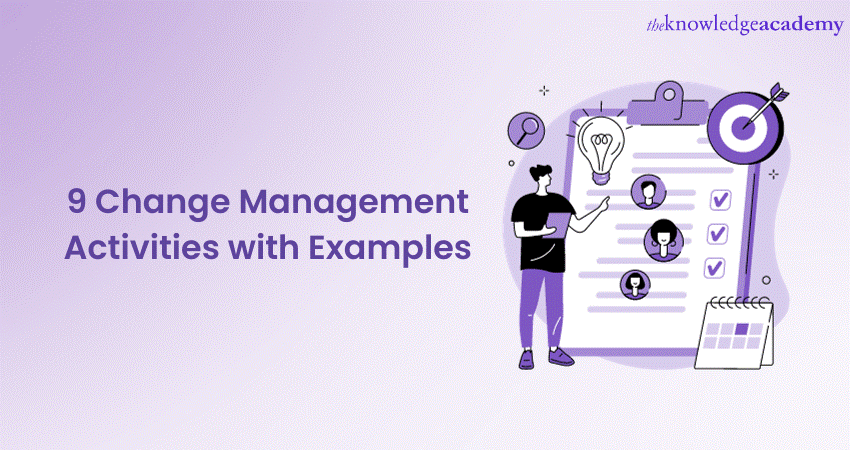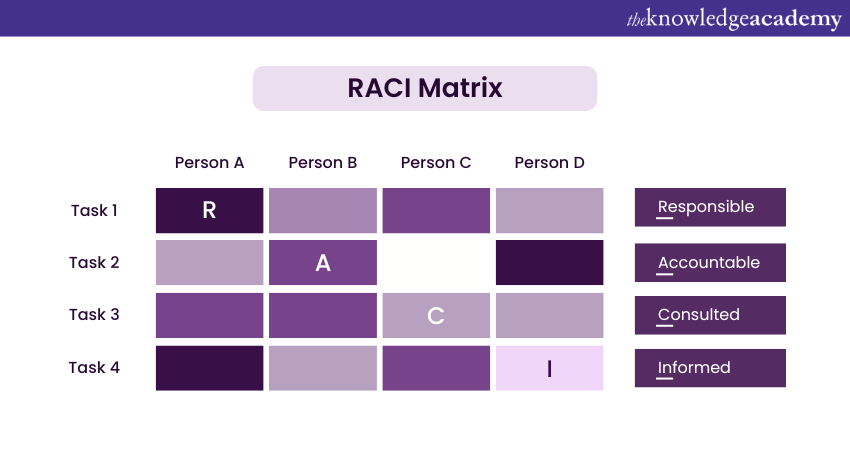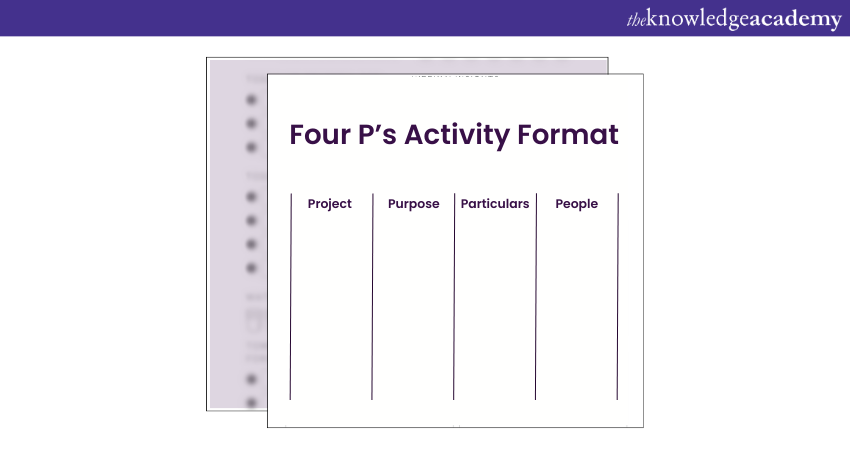We may not have the course you’re looking for. If you enquire or give us a call on +852 2592 5349 and speak to our training experts, we may still be able to help with your training requirements.
Training Outcomes Within Your Budget!
We ensure quality, budget-alignment, and timely delivery by our expert instructors.

Change is the most vital process in an individual’s personal and professional life. In the corporate perspective, organizations must invest time in Change Management Activities, to educate their employees and managers about the value and outcome of the change management plan.
Moreover, Change Management Activities also help all employees understand their personalities and thought process in relation to the change or transition occurring. Change management tools include exercises or games that will encourage the organization's employees to embrace change. Click to learn in detail.
Table of Contents
1) A brief overview of What Change Management Activities are
2) A list of the top 9 Change Management Activities with examples
a) Fishbowl discussion
b) RACI matrix
c) Cross your arms
d) Four P’s
e) The alien at dinner
f) Bounce back
g) New company
h) Change your seat
I) Ups and downs of change
3) Conclusion
A brief overview of What Change Management Activities are
Any change at a workplace demands an organised transition. An important facet of change is that it can prove to be hectic for the employees in the organisation, which is why it is vital for organisations to ensure the change occurs while simultaneously keeping their employees’ morale high with productive workflows.
Additionally, team members must be adequately prepared to adapt to transitions at their workplace. Their preparation can be done by implementing Change Management Activities, which ensures that the Project Managers can successfully lead the team to achieving the goals of the change strategy.
Furthermore, such activities are designed to motivate team members to be open and embrace company transitions with more acceptance. Some great ways to encourage team members could be to organise interactive games at staff meetings or even take all teams out on company retreats. Change management principles will help in planning, execution and evaluation of activities.
Moreover, Change Management Activities can especially help keep resistance from employees to a minimum by addressing their individual concerns, improving channels of communication, encouraging team interactions and reinforcing conflict management practices.
A list of the top 9 Change Management Activities with examples
There are a variety of change management process activities that will help your employees boost their morale and encourage them to be more aligned with the company’s vision. Here is a list of the top 9 Change Management Activities with examples:
1) Fishbowl discussion
A Fishbowl discussion is a Change Management Activity that involves a big group of stakeholders coming together to encourage decision-making processes that more inclusive in nature.
They do this by opening a new communication channel allowing for more transparency. It is basically a discussion involving the project’s prime stakeholders and another large jury of stakeholders acting as witnesses to the event.
Here are the key steps of the process involved in a Fishbowl discussion:
a) Set up: The stakeholders’ discussion can be set up with a roundtable with multiple chairs, with the observers of the discussion positioned around the roundtable.
b) Moderator presentation: The discussion’s moderator initiates the Change Management exercise by presenting a brief introduction to the topic and rules. Any two participants must take notes which they can compile for a later review.
c) Change discussion: Any six of the discussion participants must then have a discussion of the change spoken about.
d) Observer involvement: If there are any questions or counterarguments presented, an observer can be asked to take a seat and present their view.
e) Observer feedback: After addressing the questions, the discussion moderator can then request the observers for their feedback
f) Reflection and final thoughts: In the final 10 minutes of the Fishbowl discussion, the discussion can then commence, and time can be utilised to indulge in self-reflections from both participants and the observers.
Get ready for your interview with our top Change Management Interview Questions.
2) RACI matrix
Change initiatives are at a higher probability of failing if a team is unclear on their exact roles in the process of Change Management. Managers can help the team members become more aligned with the RACI matrix to provide them the clarity that they need.

The RACI matrix is basically a collection of activities that are mapped against a framework comprising of four segments, namely ‘Responsible’, ‘Accountable’, ‘Consulted’ and ‘Informed’. This framework can be utilised for the project stakeholders. The set of activities helps curb any conflicts or confusions which can come up during the team’s project workflow.
Here are the key steps of the process involved while utilising the RACI matrix:
a) Identification of the project tasks and making a vertical list of them
b) Identification of the stakeholders in the project and making a horizontal list of them at the top of the matrix
c) Assigning each of the matrix cells accordingly with ‘R’ for ‘Responsible’, ‘A’ for ‘Accountable’, ‘C’ for ‘Consulted’ and ‘I’ for ‘Informed’ labels
d) Make sure that all the project tasks are assigned to only one team member so that only they are accountable for it and there is no conflict
Here is a detailed description of each letter that makes up the ‘RACI’ matrix:
a) Responsible: These are the individuals or the stakeholders that do the project tasks. They need to accomplish the objectives or make the decision. It is helpful to know that multiple individuals can come under this label.
b) Accountable: The individuals or stakeholders who basically own the work. They are responsible for approving the completion of any project task or decision. The designated individual must ensure that their responsibilities assigned according to the matrix are for any other related activities.
c) Consulted: The individuals or stakeholders under this label are designed to provide their input before the task can be accomplished and signed-off. These members are actively involved in the project and always kept in the loop through the communication channels.
d) Informed: There are individuals or stakeholders who have to be involved in the project, as they require regular updates on the progress
Moreover, the RACI matrix basically provides Project Managers with an organised framework to help their team members gain more clarity with regards to their individual roles. This clarity also applies to the project stakeholders. It is vital for participant roles to be clear to all members regardless of how detailed the project plan may be, because the clarity can prevent many major problems from arising.
Discover the Impact of Change Management Salaries on Career Growth and Organizational Success!
3) Cross your arms
Deemed one of the easiest exercises in Change Management to perform, where the participants cross their arms the usual way and remain in that stance for a long period of time. They then change their position to fold their arms the opposite way, illustrating a simple example often used in change management models.
Now the participants will maintain this position for a while more and then relax themselves shortly after. After this activity commences, the manager can then ask their employees a few important questions:
a) “How did you feel while maintaining the first position?”
b) “What changes did you experience during your shift to the second position”
c) “How comfortable were you in the second position?”
The above questions can be a great way to gauge your employees’ experiences throughout the whole exercise. The process teaches them that change could be initially uncomfortable, although with time they would gradually become more aligned with the vision of the change.
Moreover, your employees will realise that letting go of old habits and embracing ways of life around new ones brings about a new layer of experience and confidence. The process also helps them get comfortable with fear and discomfort.
Ready to lead and drive success? Enroll in our Change Management Certification program to gain the skills and credentials you need.
4) Four P’s
The activity of ‘Four P’s’ entail creating four columns on a whiteboard and giving each of them a label such as ‘Project’, ‘Purpose’, ‘Particulars’ and ‘People’. The manager can then create various teams and encourage them to participate by making them prepare answers that are relevant to the concept of organisational change.

The manager then proceeds to taking one response from every team and assigning those that are the most relevant, to the columns on the whiteboard. Here is a description of how the answers on the whiteboard could look like:
a) Project: The project column would contain a set of changes that could help sculpt the organisation’s future for the greater good.
b) Purpose: The purpose column would describe what the positive outcomes are, that could arise from the change in the organisation. It could also discuss if the outcomes would ease out the business process. And, if it could make the workforce more efficient.
c) Particulars: The particulars column would help discuss the various elements that are necessary to facilitate the change process. For example, discussing the requirements like the software to be utilised, training to be conducted and the type of approach that may be necessary to initiate the change.
d) People: The people column would help the employees recognise the job roles that require significant change and how it could be achieved.
The ‘Four P’s’ exercise helps Project Managers enlighten their team members about the significance of change in their organisation. More importantly, it helps them have appropriate expectations of their employees. Moreover, they can guide their employees to realise how change can help them progress their careers.
Dive into the detailed Case Study on Change Management
5) The alien at dinner
This exercise may be perceived as one of the most quirky and creative Change Management Activities designed. The activity entails one employee acting as the alien in the group of employees who enact a group of people socialising at a dinner party.
As this selected employee’s role suggests, they must observe the behaviour of their fellow colleagues around them and make notes. They have to basically observe from the perspective of an alien and add a note of fascination to their notes.
Here are some key questions that the facilitator of the exercise could ask to the ‘alien’:
a) Did you notice anything fascinating among the humans?
b) Were any of the humans behaving in a similar manner during dinner?
c) Do you believe any change is necessary? If yes, please explain why and how it could be implemented?
Some key improvements the exercises could bring about in your employees are:
a) They would begin to appreciate diversity more
b) They will learn to distinguish between and analyse the positive and negative aspects of a process
c) They will begin to find potential to improve on many aspects of a project’s workflow or any elements related to the project
d) They will realise those conventional methods will not always be the appropriate way of accomplishing tasks
e) Having an open-minded attitude towards change in any situation and the ability to notice the positive and negative aspects of a process
Discover the Best Change Management Books! Read our top picks and transform your organization today!
6) Bounce back
The bounce back Change Management Activity entails all employees gathering in an open space and then throwing a ball against the ground. They must continue this activity for some time and then be asked if the ball, at any point, did not bounce back.
The employees are expected to answer ‘No’ to the question. The whole point of the exercise is to gamify the analogy which is that no matter how hard challenges may be, they will be capable of overcoming them and bouncing back on track. This is a vital lesson to be learned by employees during the change process.
Moreover, this exercise can be conducted physically in an open space or even shown on video to the employees just to provoke a conversation.
Lead your team through change by signing up for Managing Organisational Change Effectively now!
7) New company
New company is a Change Management Activity where-in all employees will need to spare a significant amount of time to complete the exercise. Here is a list of the various aspects of the exercise:
a) Gather employees from all departments into one place
b) Pick one or two employees from each department, to participate as players and form a team of ten
c) Make the team conjure an idea for a hypothetical new company
d) Ask the employees to come up with an extensive presentation, which describes the new company’s idea in detail
e) Shuffle the team players and request them to make the presentation again, re-iterate the process 4-5 times
f) Now the groups can be given time to discuss the process of building the hypothetical company, its roadmap and the plan they generated in their final draft
g) Give the team players time to share with everyone what they learned each time they shuffled their groups
8) Change your seat
The Change your seat Change Management Activity entails the facilitator positioning an object in the middle of a room and arranging their team members around the object. The team members must then shuffle and change their seats continually and make a note of what differences they observed about the object.
Additionally, they also need to make a note of how they felt when changing their seats on a continual basis. This activity can be repeated for 1-2 rounds, and they must express to everyone how they felt at every point of change.
Here are some key advantages of this Change Management Activity:
a) The repeated position changes give a new viewpoint to each employee on the object at the centre. Each viewpoint basically adds value as it helps them perceive the object in a different manner.
b) Employees learn that change is a continuous process in any organisation and there is always something new to learn
Adapt Change to everyday scenarios by signing up for Change Management Practitioner now!
9) Ups and downs of change
One of the most effective Change Management Activities, ‘Ups and downs of change’ helps employees understand their state of mind with regards to change.
The facilitator must gather all employees into a room and make them stand in one line that is horizontal to the centre of the room. The facilitator needs to then note down some keywords such as ‘Digital Transformation’, ‘Change Management’, ‘Digital Adoption’ and so on.
The facilitator has to then say each keyword, and the participants need to either take a step forward if they feel positive about it or a step backward if they have a negative notion about it. This game needs to run for about 10 rounds and the facilitator and the employees themselves will notice they are all in a zig-zag layout across the room.
The facilitator must now approach the participants who took a step back and ask which keyword made them step backwards. Attempt to understand their hesitation or doubtfulness and reason with them in a constructive and kind manner.
Conclusion
We hope that you have understood the idea of Change and the various Change Management Activities that organizations can facilitate for their employees. Change is a constant, which is why it is important for Project Managers and their employees to understand the meaning and value of change along with their perceptions towards it. Every activity has a distinct goal and a take-away which helps employees become aligned with the company’s vision and their change process, while also addressing key challenges in change management.
Design change plans to fulfil business goals by signing up for our Change Management Foundation now!
Frequently Asked Questions

The four core principles are: understand change, plan change, implement change and communicate change.

OCM stands for Organisational Change Management, which is a methodology used to manage the people's side of change in organisations. It includes understanding the impact of change, communicating effectively with stakeholders, and implementing strategies to support individuals through the change process.

The Knowledge Academy takes global learning to new heights, offering over 30,000 online courses across 490+ locations in 220 countries. This expansive reach ensures accessibility and convenience for learners worldwide.
Alongside our diverse Online Course Catalogue, encompassing 17 major categories, we go the extra mile by providing a plethora of free educational Online Resources like News updates, Blogs, videos, webinars, and interview questions. Tailoring learning experiences further, professionals can maximise value with customisable Course Bundles of TKA.

The Knowledge Academy’s Knowledge Pass, a prepaid voucher, adds another layer of flexibility, allowing course bookings over a 12-month period. Join us on a journey where education knows no bounds.

The Knowledge Academy offers various Change Management Certification, including the Change Management Foundation & Practitioner Course, Change Management Black Belt Course and Complete Change Management Assessments Training. These courses cater to different skill levels, providing comprehensive insights into Change Manager.
Our Project Management Blogs cover a range of topics related to Change Management, offering valuable resources, best practices, and industry insights. Whether you are a beginner or looking to advance your Project Management skills, The Knowledge Academy's diverse courses and informative blogs have got you covered.
Upcoming Business Skills Resources Batches & Dates
Date
 Change Management Foundation & Practitioner
Change Management Foundation & Practitioner
Thu 1st Jan 1970







 Top Rated Course
Top Rated Course



 If you wish to make any changes to your course, please
If you wish to make any changes to your course, please


